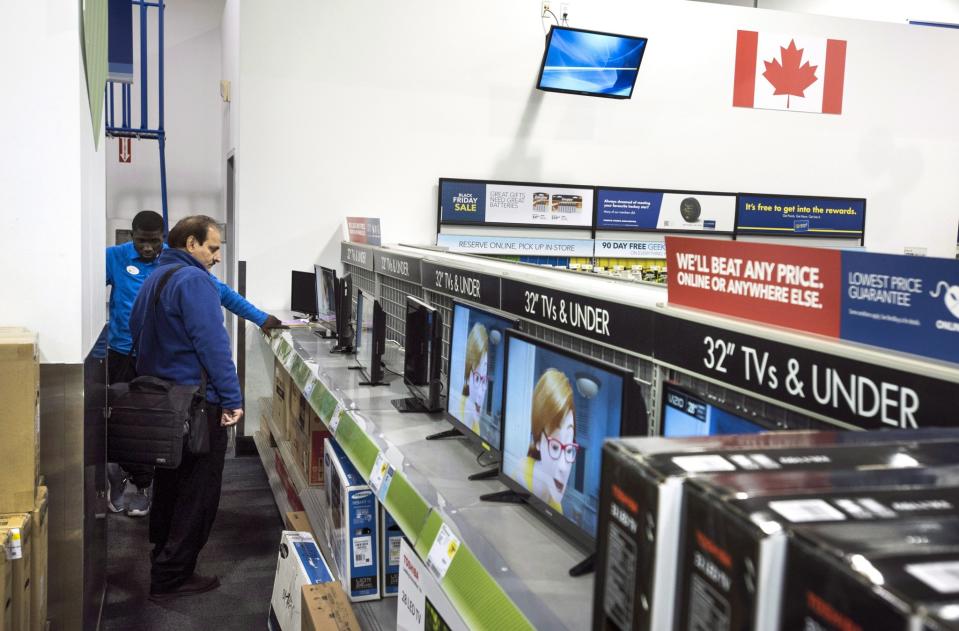Four things better to buy online -- and one that's not

As of 2014, retail e-commerce sales hit over $25 billion in Canada and are expected to hit nearly $44 billion in 2018, according to market research provider eMarketer.
However, not all industries have been affected the same way by online shopping, and depending on what consumers are shopping for online, the internet can bring its own unique advantages and disadvantages.
Here are five of some of the most common items Canadians shop for every day and whether it’s better to shop for it online, or in person at a brick-and-mortar store.
Entertainment
Entertainment is ground zero for how the internet has disrupted the way we shop — just ask Blockbuster, Rogers Video and Music World.
The reasons are obvious. Having nearly instant access to books, music, TV shows, games and more with the tap of a screen or click of a mouse — often for a fraction of the price of picking up the same or comparable item in stores — has made shopping for many entertainment items at brick-and-mortar shops obsolete.
As a result, retailers that sell or have sold books, music and movies have been shuttered or dramatically restructured as a result of Canadians’ changing shopping habits.
Those who sell physical copies of books and music, like HMV, Sunrise Records and Indigo, are trying to find a place for themselves in a world increasingly gone digital by selling a wider variety of products in store.
When it comes to CDs — the poster child of how physical media has suffered at the rise of digital entertainment — sales are continuing to dwindle.
According to Nielsen, CD sales in Canada have dropped from 6.3 million for the first half of 2015 to 5.3 million in the first six months of 2016. And while digital album sales also saw a significant drop from 5.7 million to 4.3 million, it appears Canadians are simply moving to streaming their music instead. Nielsen says there were 18.5 billion streams for the first six months of 2016 compared to 10.5 billion for the same period in 2015.
On the bright side for retailers, more Canadians are buying vinyl records, but with a modest jump from 207,000 records sold in the first half of 2015 to 287,000 sold in the same period in 2016, it won’t make up for the loss in CD sales any time soon.

Electronics
According to the 2015 Canadian E-tail report, electronics was one of the highest categories for online spending in the country.
That’s in part because of the nearly endless options to choose from online — or what’s referred to as “the endless aisle.”
“Retailers who have gotten into that category have survived because they have very robust online shopping systems,” retail consultancy company J.C. Williams Group partner Maureen Atkinson said. “You really have access to products that no store can afford to carry on an ongoing basis, but online, if you are selling to the world versus the people of Toronto, then you can afford to carry it.”
In the electronics market, Apple, for example, sells refurbished products on its website, but not in its retail stores. Many computer manufacturers, like Dell, also offer build-to-order options for laptops and desktops online.
There are also deals to be had. You can buy electronics accessories (like chargers, cords and adapters) online for a fraction of what you’d pay elsewhere. Read reviews of websites to assure you’re getting a quality product — Monoprice is a good place to start if you’re looking for deals on products that will last longer than a couple of uses.
Clothing
Shopping online for clothes has the obvious disadvantage of not being able to see how it fits before you buy it; however, according to internet domain company Cira, 42 per cent of Canadians buy clothes online, making it the top category in their report.
Atkinson says while Canadians buy more clothing in store, shopping for clothes online is popular because of access to stores, brands and sizes that would be difficult to get otherwise.
Retailers like Abercrombie and Nordstrom are in Canada, but unless you’re in the country’s largest cities, you’ll likely have a hard time getting to them. Other stores like Gap, which have a larger presence in Canada, still have sizes that you can only get online and not in stores.
There are other reasons why Canadians are shopping online for clothes, too.
“Clothing retailers have been fairly good at developing technology that deals with some of the negatives of shopping for clothing online. There’s been innovation in a lot of areas,” Atkinson added.
And where technology can’t fit the bill, good old-fashioned customer service can help to leave customers feeling rest assured that they’re safe buying online.
“Companies who are into this know that they have to have the most liberal of return policies, including they’ll pay the shipping because it’s an inconvenience if it doesn’t fit,” consumer and marketing expert Tony Chapman says.

Cosmetics
While cosmetic booths are fixtures of department stores coast-to-coast and dedicated makeup shops have sprung up in malls across the country, more women are buying their makeup online, Atkinson says.
With the internet, cosmetic companies now provide demonstrations on how their makeup looks, who should wear it and some even allow customers to take a photo and see what they’d look like in their makeup.
“Sephora is fabulous at doing that. Sephora has said one way or the other, we’re going to get them,” Atkinson said. “They have really created a very interactive website, but then also have very strong stores. In fact, they see the stores as reinforcing their online business.”
Sephora’s strategy to build a strong online presence falls in line with what other experts have said about the beauty industry.
The 2014 study Beauty and the E-Commerce Beast said that in the U.S., the beauty and personal care industry was one of the fastest-growing segments of the country’s online retail sales market despite its roots in being able to demo products in stores.
“Convenient delivery, a wider product selection, competitive pricing, and access to a wealth of information online have created an attractive alternative — or at least a strong complement — to the in-store experience,” the study said.
Online enthusiasts, who shop for “replenishment and experiential” needs, jumped from 16 per cent in 2012 to 31 per cent in 2014, and those who researched products online only to by them in stores dropped from 28 to 15 per cent in the same time frame.
The decline they say shows more evidence in consumers’ confidence in online shopping, but they warn retailers can’t ignore those who shop in stores and should continue to strive to meet their needs while looking out if they’re moving their shopping online.
Groceries
Outside of the likes of Longo’s Grocery Gateway and other grocery delivery services, shopping online for weekly staples hasn’t taken off as much in Canada as it has in other countries.
“In England, 15 per cent of groceries are bought online. In Canada and the United States, it’s probably six or seven per cent,” Chapman said. “The economics of shipping a case of Pepsi across the country as big and as broad as Canada doesn’t make sense yet.”
There are several other factors hampering the success of online grocery shopping in Canada.
“Part of it has to do with the retailers enabling it,” Atkinson said. “How you actually make money doing it is a huge challenge for the retailers.”
Customers also like to pick their own fruit and vegetables, instead of having someone else do it, she adds.
However, people have shown interest in shopping for specialty grocery items that may be hard to find elsewhere, online.
“If you are on a very restricted diet. If you have allergy problems, trying to get products you can eat may be difficult and so that’s where that endless aisle is a really good benefit of the online world,” Atkinson said.

 Yahoo Finance
Yahoo Finance 
